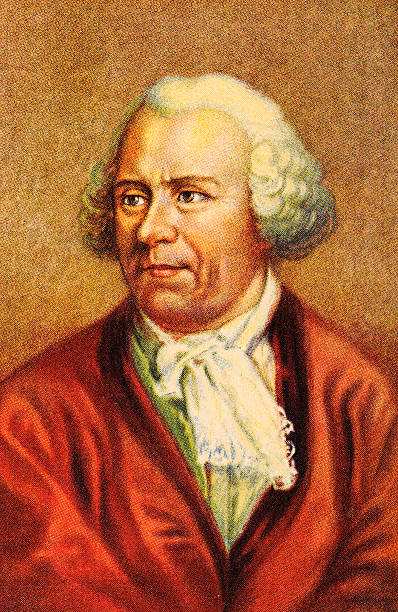Leonhard Euler (1707-1783) was an 18th-century Swiss mathematician and physicist. Widely regarded as one of the greatest mathematicians of all time, Euler made significant contributions to various fields, including number theory, topology, mechanics, and fluid dynamics. Euler’s extensive body of work includes the development of Euler’s formula, the introduction of modern terminology and notation, and pioneering contributions to graph theory. His profound impact on mathematics and science earned him the title “The Master of Us All.”
Euler’s early education was shaped by his father, Paul Euler, who was a pastor and mathematician. Paul Euler recognized his son’s talent and provided him with a strong foundation in mathematics and the sciences. Leonhard Euler’s early exposure to the works of influential mathematicians, such as Johann Bernoulli and Christian Goldbach, fueled his burgeoning interest in the subject.
In 1727, Euler entered the University of Basel, where he initially studied theology, following in his father’s footsteps. However, Euler’s passion for mathematics led him to shift his focus, and he eventually earned his master’s degree in philosophy and literature. His academic prowess and mathematical acumen drew the attention of Johann Bernoulli, who became a mentor and supporter of the young Euler.
At the age of 20, Euler embarked on an academic journey that took him to the Imperial Russian Academy of Sciences in St. Petersburg. Euler’s move to Russia marked the beginning of a long and fruitful career, as he immersed himself in a broad spectrum of mathematical and scientific inquiries.
Euler’s early contributions covered diverse areas of mathematics. In 1736, he tackled the famous “Seven Bridges of Königsberg” problem, formulating the groundwork for graph theory. Euler’s solution, known as Eulerian paths and circuits, laid the foundation for the branch of mathematics dedicated to the study of networks and connectivity.
His reputation continued to grow, and in 1741, Euler was invited to the Berlin Academy of Sciences by Frederick the Great. During his time in Berlin, Euler produced some of his most influential work, including his investigations into the theory of elasticity, fluid dynamics, and his renowned introduction of the concept of mathematical functions.
In 1745, Euler faced a significant personal challenge when he lost sight in his right eye due to overwork. Despite this setback, Euler remained undeterred, adapting to his visual impairment and continuing his research with remarkable productivity.
One of Euler’s most significant achievements came in the field of number theory with his work on Diophantine equations, a type of equation involving only integers. Euler made substantial contributions to the theory of numbers and introduced innovative methods for solving Diophantine equations. His insights paved the way for future developments in number theory.
Euler’s impact extended to the realm of physics, particularly mechanics. His work on the three-body problem, analyzing the motion of three celestial bodies under mutual gravitational attraction, marked a significant advancement in celestial mechanics. Euler’s studies in mechanics also included his formulation of Euler’s laws of motion, which became fundamental principles in classical mechanics.
In 1766, Euler experienced another personal setback when he lost sight in his left eye. Undeterred, he continued his prolific output with the assistance of his sons and students, using innovative techniques such as the large print and the polygraph, a writing device that allowed him to simultaneously record multiple equations.
Euler’s achievements in mathematics were not confined to theoretical work; he made significant strides in the development of mathematical notation. Euler introduced and popularized many symbols and notations that are now standard in mathematics, including the use of the symbol “e” for the base of the natural logarithm, the Greek letter “Σ” for summation, and “i” for the imaginary unit.
In 1766, Euler returned to St. Petersburg, where he continued his work until his death. Despite his visual impairment and declining health, Euler’s intellectual prowess remained undiminished. He tackled complex problems in various fields, including astronomy, number theory, and geometry.
Leonhard Euler passed away on September 18, 1783, in St. Petersburg, leaving behind a legacy that transcends the boundaries of mathematics and science. Euler’s impact on mathematics is immeasurable, with over 800 published works covering a vast array of topics. His influence extended to subsequent generations of mathematicians, and many mathematical concepts and theorems bear his name in tribute to his contributions.
Euler’s legacy also endures in the Eulerian circuits and paths of graph theory, Euler’s formula in complex analysis, Euler’s identity linking fundamental mathematical constants, and Euler’s equations in fluid dynamics, among many others. The sheer breadth and depth of Euler’s work have cemented his status as one of the most prolific and influential mathematicians in history.
In addition to his scholarly pursuits, Euler’s engaging writing style and his ability to convey complex ideas with clarity contributed to his popularity among students and fellow mathematicians. His correspondence with other scholars, including Daniel Bernoulli and Christian Goldbach, provided insights into the collaborative nature of mathematical inquiry during the 18th century.
Euler’s impact reached beyond the academic realm; his work influenced the practical applications of mathematics in engineering, physics, and technology. Euler’s ideas continue to resonate in contemporary mathematics, with ongoing research exploring new facets of the mathematical landscape he helped shape.
